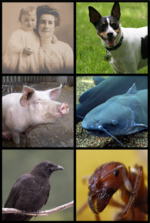Liebig's law of the minimum, often simply called Liebig's law or the law of the minimum, is a principle developed in agricultural science by Carl Sprengel... 12 KB (1,631 words) - 05:46, 25 April 2024 |
success. The further elaboration on the theory of tolerance is credited to Ronald Good. Points out the second limitation of Liebig's law of the minimum - that... 2 KB (334 words) - 10:46, 24 October 2021 |
 | Plant nutrition (category Biology and pharmacology of chemical elements) constituent or metabolite. This is in accordance with Justus von Liebig's law of the minimum. The total essential plant nutrients include seventeen different... 57 KB (7,336 words) - 18:48, 6 March 2024 |
Crop yield (redirect from Law of physiological relations) articulated a "law of physiological relations". It was compared to the law of diminishing returns in 1942, when Liebig's law of the minimum and the limiting... 7 KB (868 words) - 13:53, 26 April 2024 |
ecological processes: Carrying capacity Biological competition Liebig's law of the minimum Niche differentiation Abiotic component Biotic component Community... 2 KB (257 words) - 18:46, 3 January 2023 |
 | Diminishing returns (redirect from The law of diminishing returns) Diseconomies of scale Economies of scale Gold plating (project management) Learning curve Experience curve effects Liebig's Law of the minimum Marginal value... 22 KB (2,786 words) - 11:56, 11 December 2023 |
 | or lysotrophic nutrition is a process of chemoheterotrophic extracellular digestion involved in the processing of decayed (dead or waste) organic matter... 7 KB (757 words) - 19:02, 17 March 2024 |
 | Algonquian peoples (category Indigenous peoples of the Northeastern Woodlands) this practice kept the population down, with some invoking Liebig's law of the minimum.[citation needed] The southern Algonquians of New England relied... 16 KB (1,677 words) - 12:46, 21 April 2024 |
 | Ecological pyramid (redirect from Pyramid of numbers) show the biomass or bioproductivity at each trophic level in an ecosystem. A pyramid of energy shows how much energy is retained in the form of new biomass... 9 KB (1,004 words) - 05:17, 1 May 2024 |
is based on Liebig's Law of the Minimum, which states that growth is controlled not by the total amount of resources available, but by the scarcest resource... 14 KB (1,811 words) - 21:58, 28 March 2024 |
 | Apex predator (redirect from List of apex predators) predator, is a predator at the top of a food chain, without natural predators of its own. Apex predators are usually defined in terms of trophic dynamics, meaning... 33 KB (3,259 words) - 00:15, 24 April 2024 |
by the oxidation of electron donors in their environments. These molecules can be organic (chemoorganotrophs) or inorganic (chemolithotrophs). The chemotroph... 8 KB (816 words) - 03:47, 27 April 2024 |
 | fungi grow as a branching network of hyphae. While bacteria are restricted to growing and feeding on the exposed surfaces of organic matter, fungi can use... 5 KB (557 words) - 23:53, 17 March 2024 |
consumer and the base of the web. The mean chain length of an entire web is the arithmetic average of the lengths of all chains in the food web. The food chain... 17 KB (1,932 words) - 01:08, 30 April 2024 |
 | Ecosystem model (section The Lotka–Volterra equations) forecasting Gordon Arthur Riley Land Surface Model (LSM version 1.0) Liebig's law of the minimum Mathematical biology Population dynamics Population ecology Rapoport's... 23 KB (2,451 words) - 22:47, 8 November 2023 |
which case it would be located in the first level of the food chain above the producers. Some carnivorous plants, like the Venus flytrap, are classified as... 5 KB (597 words) - 23:24, 7 April 2024 |
Ecological efficiency (redirect from Ten percent law) one trophic level is generally only 10% of the net production at the preceding trophic level (the Ten percent law). Due to non-predatory death, egestion... 10 KB (1,535 words) - 12:08, 31 March 2024 |
 | Carnivore (redirect from Beast of prey) requirements derive from the consumption of animal tissues (mainly muscle, fat and other soft tissues) whether through hunting or scavenging. The technical term... 17 KB (1,651 words) - 20:51, 24 April 2024 |
 | Critical path method (redirect from Critical Path Method of Scheduling) technique Critical chain project management Liebig's law of the minimum List of project management software List of project management topics Main path analysis... 19 KB (2,250 words) - 18:38, 12 July 2023 |
 | Omnivore (redirect from List of omnivorous animals) protein, fat, and fiber, and metabolize the nutrients and energy of the sources absorbed. Often, they have the ability to incorporate food sources such... 28 KB (2,818 words) - 15:23, 5 April 2024 |
 | theory relates to the selection of combinations of traits in an organism that trade off between quantity and quality of offspring. The focus on either an... 28 KB (3,131 words) - 20:18, 24 April 2024 |
 | Nutrition (redirect from Outline of nutrition) hydrolytic enzymes. Liebig's law of the minimum – Growth is limited by the scarcest resource Nutrient density – the proportion of any array of a single nutrient... 36 KB (4,008 words) - 21:17, 28 April 2024 |
 | Species richness (category Measurement of biodiversity) richness is the number of different species represented in an ecological community, landscape or region. Species richness is simply a count of species, and... 7 KB (823 words) - 18:37, 8 December 2023 |







